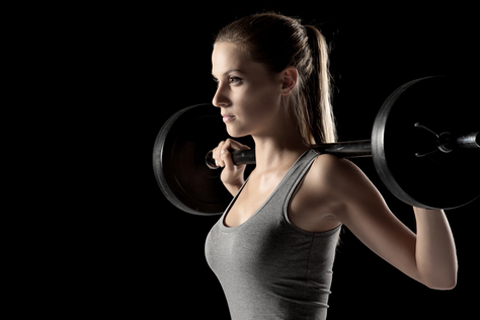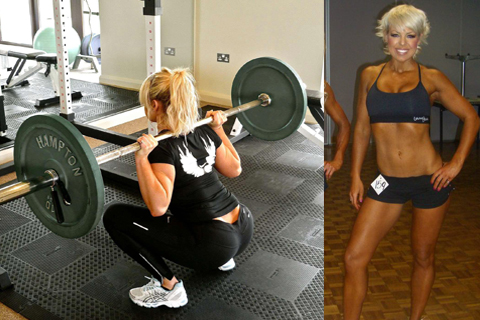Female Weight Lifting: Why Women NEED To Lift Compound Heavy
by Matt Hodges
06 July 2012
Ive recently had a heated debate with a female client of mine about this hot topic in the fitness industry. It became clear to me the unbelievable misconception of female weight lifting and actually how much people listen to whats written in the media. I thought it only appropriate, considering a high population of our clients that are female, that we should write an article to give our views on the subject.
You can open any woman’s magazine or pick up a book about exercise by a well-known celebrity trainer and chances are you’ll read how lifting weights can help tone and sculpt your body. The author will wax lyrically about how you can shape your muscles by using light weights and performing high repetitions, but is this really the truth? One celebrity trainer caused an outrage in the fitness community recently by publishing that women should NEVER lift weights heavier than 1.5kg (is it me or does the average hand bag weigh more than this?), be wary of undertaking Pilates and Bikram Yoga and to stop spinning classes because it makes the legs unsightly! What an absolute load of b******!
This sort of advice does nothing to undo the widespread myth that women shouldn’t lift heavy weights. There is an all too common misconception that women who lift heavy weights will “bulk up” and develop a masculine figure. It’s time this myth was well and truly dispelled…
Hormones
With the exception of an infinitesimal number of “genetic freaks”, women are not hormonally equipped to develop large muscles even if they lift heavy weights. The most dominant hormone in a woman’s body is oestrogen which is not known for its anabolic (muscle building) effect.
Ironically, a great many men actually fail to develop large, muscular physiques despite lifting heavy weights for years on end even though they are “hormonally primed” for muscle growth. Men typically have ten times the amount of the anabolic hormone testosterone compared to women so the chances of women building muscle to the degree that they lose their femininity is slim at best!
Bodybuilders use very specific training methods, a myriad of special supplements and strict dietary regimes to develop their extremely muscular physiques. Building big masculine muscles takes time, dedication and persistence and is not something that can be done “by accident”. Don’t fear the heavier weights – you won’t wake up one morning looking bulky and masculine; a woman’s body is just not hormonally primed for developing big muscles.
The compound part….
I am still astonished by how many women I get through the door who have come from other personal trainers or other gyms who cant deadlift, who have never heard of a glute bridge or don’t know what a hanging clean is. Even at my personal gym I think I have only seen one woman in the past 6 years use the squat rack. It seems that the protocol for females is to give them as many crunches, bicep curls and tricep extensions as an hour will allow without actually educating them in why they should be focusing on more compound movements (movements that use more than one joint in the exercise). I think a huge part of this, again, is mis-education by the media. Only the other day we see Londons’ so called top celebrity trainer in the Daily Mail going through spot reduction techniques (targeting an area for fat loss). ’Do lots of bicep curls for toned arms’, ‘Make sure you do tricep extensions for the bingo wings’, ‘Back extensions for lower back fat’. I mean come on, who are you trying to kid?!? I think you can gather that I do NOT believe in spot reduction AT ALL and until some heavy research comes out proving me other wise, ill stick to giving my clients big compound movements.
As previously mentioned compound movements use more than one joint at a time. An example: a bicep curl is an isolation movement (elbow joint flexion only) whereas if you were to add a shoulder press into the equation we are now moving both the elbow, the shoulder joint, partial parts of the wrist and, if heavy enough, I am sure the client will be push-pressing the weight over the head and therefore using the knees and ankles. With the multitude of joints and muscles working together it would only be common sense to understand that this is far more efficient in the reduction of fat (increases metabolic rate) and gives a much more overall body workout. Add a heavier weight in there and the body has no option but to adapt in a positive way.
The heavy part….
So now you know you don’t need to worry about turning into a she-hulk as a result of lifting heavy weights, let’s look at why you NEED to incorporate some heavy lifting into your weekly exercise routine.
Lifting heavy weights will:
- Increase bone mass and reduce your risk of suffering osteoporosis
- Improve your strength so that everyday activities are less demanding
- Increase your resting metabolic rate so you burn more calories even at rest – this means you’ll get leaner, quicker
- Firm up your “problem areas” such as your backside, backs of your arms and your thighs more effectively than lighter weights
- Save you time as heavier workouts tend to be shorter workouts
- Improve your core strength and posture
- Deliver better results in less time compared to low weight/high repetition training
- Develop confidence and self-assurance
- Reduce your likelihood of developing non-specific back pain
- Make it easier to maintain your ideal weight
Girls who lift heavy
To give you more a visual example I’ve included my good friend Rachel Guy. Rachel is one of the worlds’ leading female strength & conditioning coaches, currently residing in Australia. Rachel is a massive advocate of female’s lifting heavy and she has the body to match it. I’m sure you’ll agree there is nothing butch or bulky about Rachels’ physique.
With so many benefits associated with heavy lifting it’s a wonder anyone still believes the “light is best” myth! Lifting light weights for high repetitions all but guarantees little or no progress and a whole lot of wasted time and effort.
Use a professional
Lifting heavier weights should not be taken lightly though – pun intended. The main consideration with heavier lifting is safety. Lifting loads that are close to your maximum requires expert tuition and guidance and that’s where it really pays to employ the services of one of our qualified personal trainers in London.
We believe that lifting heavier weights is the perfect exercise prescription for most women but you don’t have to take our word for it. Our personal training clients in London are enjoying the benefits of our unique myth-busting approach to exercise which, combined with our nutritional advice, are developing their best body ever in record time. Lifting heavier weights really does work!
This article was written by Matt Hodges, you can see all his articles here.







